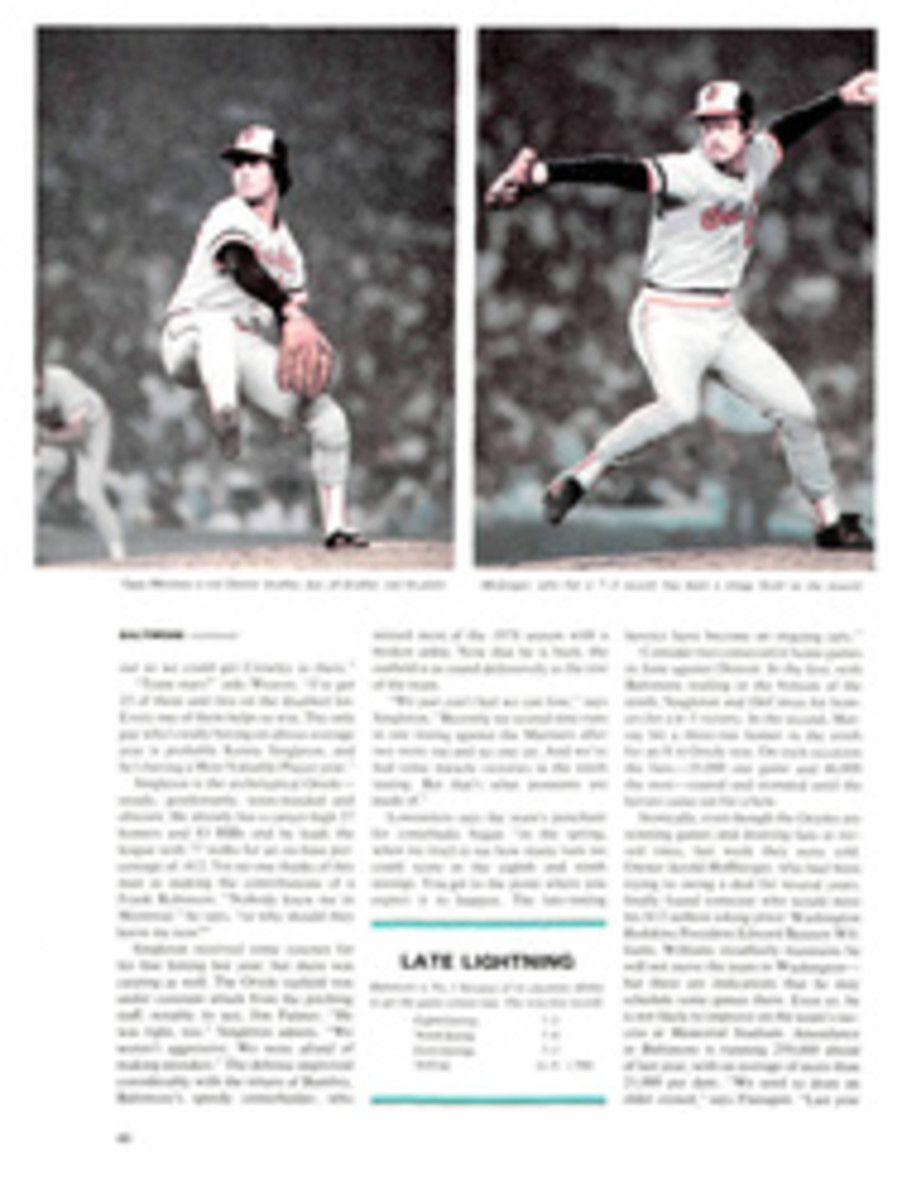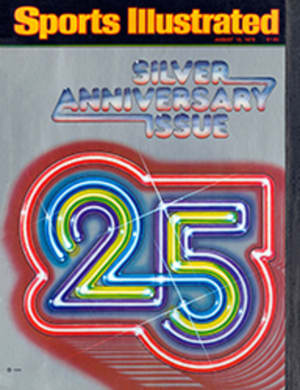
LETTER FROM THE PUBLISHER
This is the 25th anniversary of our first issue, but not the first time that this space has been used to call attention to SPORTS ILLUSTRATED'S longevity. That occurred in February of 1955, when we reached our sixth-month milestone. We didn't dare wait an entire year; in our infancy it was reassuring to proclaim our existence, inasmuch as the smart money in the publishing industry insisted that a weekly sports magazine could not survive. This opinion was somewhat borne out by the fact that SI lost $6 million in 1954.
Nearly a decade went by before SI broke into the black. During the lean times one thing saved us: the loyalty of our readers. At SPORTS ILLUSTRATED'S financial nadir, when advertising was skimpy—the first ad director quit to become a Methodist minister—our readers kept the faith, renewing their subscriptions at a reassuring rate. Obviously the public wanted a comprehensive and literate sports weekly, but various shibboleths persisted: that sports fans weren't upwardly mobile, that they would not appreciate quality sports writing and that sports had only limited and parochial appeal—there might be football fans and golf fans and track fans, but who would be interested in a sports magazine of broad national appeal?
Well, in its 25 years SI's circulation has increased fivefold from 450,000 to 2,250,000. It might be said that the interest in and reach of sports in America have increased by about the same degree. Ray Kennedy's retrospective article beginning on page 52 so attests.
We believe we have been a major influence in creating a sense of American sport, and in raising the level of the quality of sports writing. Moreover, SI has influenced how sports are covered. We obliged fans, the daily press and the networks to consider sports from a national point of view—and as a continuous endeavor. It might seem startling now, but the single most telling negative argument made at Time Inc. against launching a sports magazine was that there would be nothing important to write about from the bowl games on Jan. 1 until the baseball season opened 3½ months later. By the same token, perhaps the wisest decision never made was to turn SPORTS ILLUSTRATED into a fortnightly or monthly. There was much talk to that effect when the magazine was struggling, but Henry Luce, Time Inc.'s co-founder and longtime editor-in-chief (who was no great sports fan), firmly opposed such a change "because sports occur on a weekly basis" and no sports periodical could expect to be successful unless it could be current.
What the magazine was in the early years is still a subject of debate. If it is true that we heeded the naysayers and tried to be all things to all men on Madison Avenue—a fashion magazine, a food magazine, a travel magazine and a trendy magazine as well as a sports magazine—where did all those readers come from? Although SI had always covered hard sports thoroughly, that fact was obscured by a widespread belief that it was obsessed with the chic and the exotic. When Andre Laguerre became managing editor in 1960, he observed, "Sometimes we outgeneral ourselves as if to conceal the fact that we are a sports magazine in the first place."
As SI became more cohesive (and less exotic), it prospered. Today it stands fourth among all U.S. magazines in advertising revenue. But neither Laguerre nor his successors Roy Terrell and Gilbert Rogin accepted the notion that it should deny its pages to all but hard sports.
We consider the environment, recreation, travel, sedentary games, fashion, new sports-and-games-related products, books, the electronic media and movies to be within our purview—and we still get complaints from a few readers that those ain't sweat-and-muscle pursuits. Every year one of our best-selling issues at the newsstands and the one that generates the most reader response is the swimsuit number. Chances are, we'll keep publishing it. Nobody's perfect.
In a more serious vein, we have published special series that seemed to us to be models of their kind—on the squalid side of boxing, the black athlete, women in sport, television's mushrooming presence, money in sport, violence in football. The magazine's overall design, conceived by Art Director Dick Gangel, has also set journalistic standards.
Because we have been around this long, only the few remaining staffers who have been on board for the whole trip can recall the clannishness and esprit that marked the early days. Nine on the staff today—William Bernstein, Arthur Brawley, Robert Creamer, Betty DeMeester, Harvey Grut, Mervin Hyman, Virginia Kraft, Eleanore Milosovic and Coles Phinizy—helped put out Vol. I, No. 1.
It was not just alien experts who, early on, held no brief for a sports weekly. The new magazine was often disparaged within Time Inc.—Muscles it was called, with no affection—and for the employees obliged to move from the affluence and security of TIME or LIFE to the spartan Muscles environs, it was like being ordered from the cathedral to mission work. Ralph Graves, Time Inc.'s editorial director, recalls ruefully that he was sure no magazine with such an attenuated name could possibly survive, not in the snappy world of TIME, LIFE and FORTUNE. He just as ruefully admits he didn't reckon with the even snappier SI.
The real pioneers "came downstairs with Sid," Sidney L. James, the first managing editor, having led a redoubtable band from the 33rd floor of the old Time & Life Building in New York's Rockefeller Center to the 17th and then to the fourth floor. Associate Art Director Grut is the most senior remaining staffer, having begun work for Muscles on Aug. 15,1953.
The original concept was that about 75% of SI's contents would come from outside contributors. Quickly this was found to be undesirable; the reverse is now true. SI is mostly staff-written. It was also hoped that the magazine could be named Sport, but that title was held by Macfadden Publications. They wanted $250,000 for it; Luce offered $200,000. He bought the title SPORTS ILLUSTRATED for $5,000, plus a lifetime subscription to the new publication, from the man who held the rights to a defunct monthly so named.
Jim Murray, the renowned sports columnist for the Los Angeles Times, was a prepublication staffer. Another was a young author who came a cropper trying to write a caption about a horse jumping over a fence. He could not satisfy the editors and finally just upped and quit, leaving in his typewriter the desperate words, "The——horse jumped over the——fence." That was Kurt Vonnegut Jr.
The fledgling staff persevered, and the inaugural issue, dated Aug. 16, 1954, featured a cover shot taken at Milwaukee County Stadium with Eddie Mathews at bat and Wes Westrum catching. Augie Donatelli was the ump. (Westrum and Mathews are now scouts for Atlanta and Texas, respectively; Donatelli is retired and lives in St. Petersburg, Fla.). The lead story by Paul O'Neil was about Roger Bannister (who was to be our first Sportsman of the Year) whipping John Landy in the first race of four-minute milers. A copy of the issue in good condition is now worth $25.
In the 1,284 issues since then, Muhammad Ali has been on the cover most often, 25 times, beginning in 1963. Jack Nicklaus is next with 18 covers, followed by Kareem Abdul-Jabbar with 15, Arnold Palmer with 14, Bill Walton with 13 and Sonny Liston with nine.
Our readers take an unusual amount of interest in the covers because the subjects are supposed to be jinxed. Swimmer Shirley Babashoff got cold feet and hid in the ladies' room when she was supposed to pose in 1976. She was cajoled out by a persuasive female staff member, and pose she did, when reminded that Mark Spitz had been a cover subject one Olympics earlier and had won seven gold medals, Babashoff won a relay gold and four silver medals at Montreal, a performance not quite up to what she had anticipated, but certainly no disaster. The argument that a jinx exists naturally includes, as an example, a football cover, in our fourth autumn, with the billing: WHY OKLAHOMA IS UNBEATABLE. Notre Dame defeated the Sooners that week on national TV., Nobody's perfect. Not even Ali, our champion cover subject. After all, he lost three of 59 fights.
On Thursday night in Milwaukee, Mathews (who went on to the Hall of Fame despite first-coverdom), Westrum and Donatelli reassemble to have the inaugural cover shot again. And we'll be lifting a glass to you, the reader, for making this quarter century and that reunion possible.
PHOTO
THE BRAVES' EDDIE MATHEWS—AND SI—COME TO BAT

